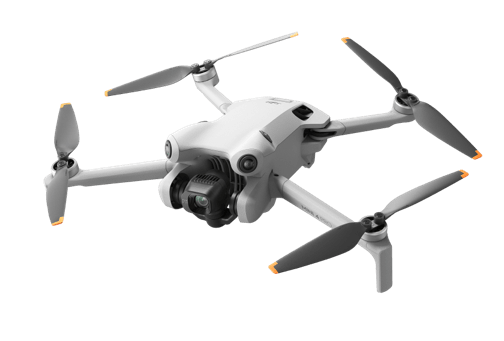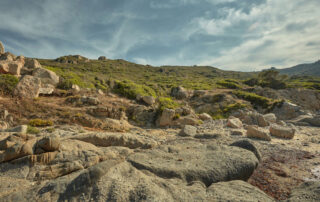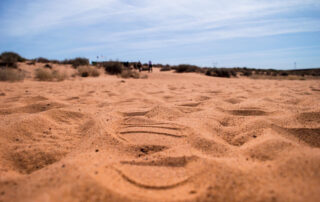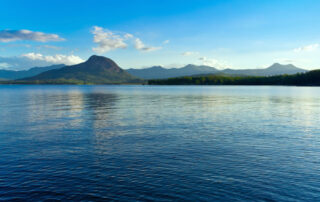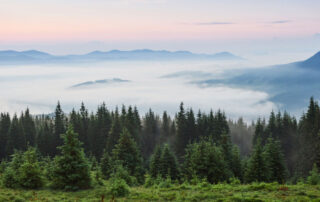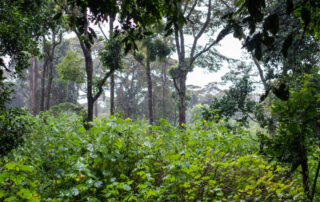
Learn how the sun’s uneven heating drives air currents that directly affect drone flight. Part 1 explains how solar energy creates air movement, setting the stage for local weather patterns. Part 2 explores how different surfaces—like rocks, water, and vegetation—interact with these currents, creating updrafts and downdrafts that can impact drone stability and control.
The Sun’s Heat

It All Begins with the Sun
Weather on Earth originates with the sun’s heat energy. This energy is distributed unevenly across the planet. Regions near the equator receive direct, concentrated sunlight, while areas closer to the poles experience sunlight at an angle, dispersing its intensity over a broader surface area.
This uneven heating of the earth’s surface creates the conditions necessary for air movement, pressure differences, and the development of all weather patterns.
Enter Convection Currents & Global Air Circulation
As the sun warms the Earth, convection currents form on the surface, driving the movement of air.
At the equator, sunlight strikes the Earth directly, intensely heating the surface and creating warm air that rises. In contrast, near the poles, sunlight spreads over a larger area, resulting in less intense heating and cooler air.

Every weather-related phenomenon involves or leads to a heat exchange.
Convection currents, characterized by vertical movement, occur as warm air rises and cool air descends. The warm air near the surface becomes lighter and rises, while cooler air sinks to replace it, creating vertical air movement.
These convection currents create differences in air pressure, which drive global air circulation. This circulation plays a key role in shaping weather phenomena like thunderstorms and wind patterns, affecting everything from daily weather to large-scale climate systems.
Ultimately, it’s the sun’s uneven heating of the earth’s surface that sets the stage for the dynamic weather systems we experience.
Earth’s Surface

Weather isn’t just about the sky—it starts right at the surface. Different surface types influence the movement of air, creating updrafts and downdrafts, which impact the stability of an sUAS in the air.
Imagine the ground is like a big sponge soaking up sunlight. The parts of the ground that are hard—like rocks, sand, plowed fields, pavement, or city streets—get hotter way faster than softer areas, like grass, forests or water.

Updrafts: Surfaces That Heat Quickly
When hard surfaces heat up, they warm the air right above them. Hot air is like a balloon—it gets lighter and starts floating upward. The result is called an updraft.
Here’s why it happens:
- The sun heats things unevenly: Some surfaces, like sand and pavement, get super hot because they hold onto the heat more.
- Warm air rises: When the air near these surfaces warms up, it gets lighter and floats up into the sky.
- Cool air rushes in: As the warm air rises, cooler air from nearby comes in to take its place, which keeps the process going.
These rising air currents can make things turbulent for drones or planes flying nearby, so pilots need to watch out.
Updrafts are especially prominent in areas with:
- Rocky Terrain: Quick heating creates strong thermal activity.
- Barren Land: Lack of vegetation accelerates heat absorption and release.
- Urban Areas: Pavement and rooftops amplify temperature contrasts.
Downdrafts: Surfaces That Retain Heat
In contrast, soft surfaces like water, forests, and dense vegetation absorb heat more slowly and retain it longer. These cooler surfaces lead to downdrafts, vertical currents of sinking air.
Here’s how it works:
- Cold air is heavy: If a storm or rain cools the air, or if air moves over something cold like a lake or snow, it becomes heavier.
- Cold air falls: Just like a rock drops in water, this heavy, cold air sinks quickly toward the ground.
- Pushes air down: As the cold air descends, it forces the air below it to move downward too, creating a strong downward wind.
Think of it like pouring water from a bucket. The water rushes down, splashes, and spreads out when it hits the ground. That’s what downdrafts do to the air—they can make sudden gusts and push everything downward.
For drones or planes, downdrafts can feel like the air is shoving them toward the ground, so pilots have to be extra careful.
Areas prone to downdrafts include:
- Bodies of Water: The cooling effect of water often generates steady downdrafts.
- Dense Forests: Shaded vegetation retains cooler temperatures.
- Dense Vegetation: Similar to forests, these areas create gradual heat release.

